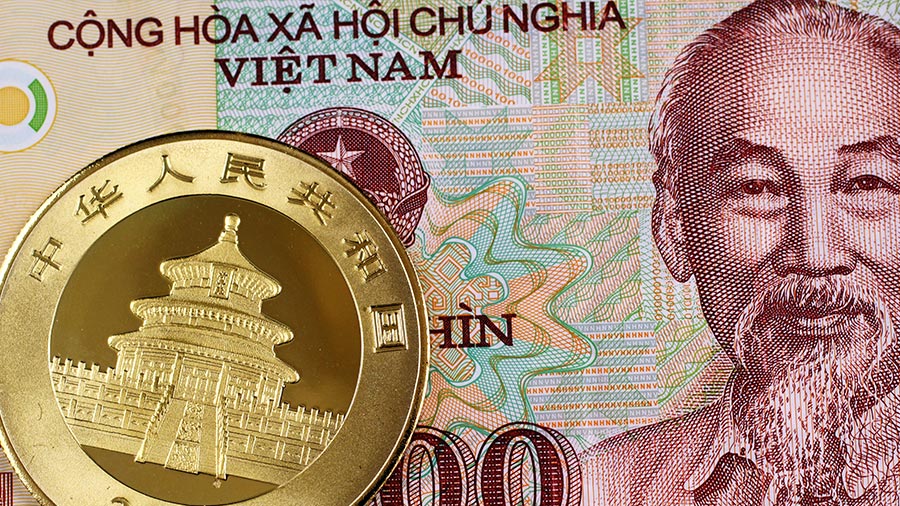Chinese FDI in Vietnam: Growing Economic Ties, Despite Strains
For the past 25 years, Chinese investments in Vietnam and bilateral trade between the two nations has grown steadily despite issues such as the South China Sea and increasing cooperation between Vietnam and countries such as US, India, and Japan. The Chinese mainland has emerged as the eighth largest investor in Vietnam, with the actual FDI much higher if we include their affiliates in Hong Kong and Macau. Over 60 percent of all Chinese FDI focuses on manufacturing and processing, with a majority of the investment focused on labor-intensive industries.
Trade agreements
Both countries are parties to the ASEAN China FTA, which created the largest free trade area in the world. Apart from ASEAN China FTA, both countries are currently negotiating the Regional Comprehensive Economic Partnership (RCEP), which includes the ASEAN member states, and the six states with which ASEAN has existing free trade agreements, which include Australia, China, India, Japan, South Korea, and New Zealand.
![]() RELATED: Pre-Investment Advisory Services from Dezan Shira & Associates
RELATED: Pre-Investment Advisory Services from Dezan Shira & Associates
Bilateral trade
Trade volumes between the two nations have increased significantly in the last few years. Vietnamese exports to China increased at a faster pace in comparison to its imports. According to Chinese statistics, its exports to Vietnam grew by an average annual rate of 18 percent during 2010-2016, and its imports from Vietnam grew by 26 percent.

Major imports
Over 70 percent of Chinese imports into Vietnam are intermediate goods such as machinery, electrical and electronic products, textiles and fabrics, base metals and minerals, and chemicals. In the last 2-3 years, other goods such as plastic and clothing products for consumer purposes also accounted for a small part of Chinese imports in Vietnam.
In the first seven months of 2017, China has emerged as the largest exporter to Vietnam at US$ 31.59 billion, an increase of 15.3 percent compared to the same period in 2016. The below information is the percentage share of different product in total imports.

Major exports
Major Vietnamese exports to China include machinery, electrical and electronic products which account for more than half of the total exports. Other products include food items, cotton, fuel, and oil products.
Vietnam’s exports in the first seven months of 2017 stood at US$ 15.62 billion. The below information is the percentage share of different product in total exports.

![]() RELATED: Japan’s Investments in India Unveil Growing Economic Partnership
RELATED: Japan’s Investments in India Unveil Growing Economic Partnership
Chinese FDI in Vietnam
China’s first FDI in Vietnam was in 1991 when a Guangxi enterprise (China) joint ventured with a Vietnam group to open Hoa Long restaurant in Hanoi. Since then, Chinese FDI has increased, although not consistently. For example, China’s FDI in Vietnam in 2012 was US$ 312 million, while in 2013; it rose to US$ 2.3 billion. China’s 2016 FDI in Vietnam accounted for 7.7 percent of the total FDI at US$1.88 billion.
Cumulative FDI
As of March 2017, the cumulative Chinese FDI stood at US$ $11.19 billion for 1,616 active projects. The average capital per project was US$6.9 million, much lower than the overall average. Chinese investment is mostly in the processing and manufacturing industry, accounting for 61.4 percent of total investment capital, followed by production and distribution of electricity, gas, and water, and air conditioning at 18.2 percent and real estate at 5.6 percent.
Binh Thuan province attracted the most FDI, with total registered investment capital of US$2.03 billion, for only seven projects, accounting for 18.1 percent of the total FDI from China.

Market entry strategy for FDI firms
As much as 80 percent of all engineering, procurement, and construction (EPC) contracts in Vietnam are awarded to Chinese contractors, accounting for 18.4 percent of total registered capital to be in the form of build-operate-transfer (BOT), build-transfer (BT), and build-transfer-operate (BTO) contracts. In a close second, joint ventures, business cooperation contracts, or joint stock companies account for 15 percent of the total registered capital. In terms of FDI, investments from affiliates in Macau and mostly Hong Kong have outweighed FDI from the Chinese mainland.
Commercial presence
There are numerous ways to establish a commercial presence in Vietnam.
- Representative Office
This is the most common form of presence in Vietnam for foreign companies, particularly those in the first stage of a market entry strategy. A representative office cannot conduct commercial or revenue generating activities.
- Limited-liability Company
It may take the form of either:
- A 100% foreign-owned enterprise; or
- A foreign-invested joint-venture enterprise between foreign investors and at least one domestic investor.
- Joint-stock Company
A joint-stock company is a limited liability legal entity established through a subscription for shares. By law, this is the only type of company that can issue shares. A joint-stock company may be either 100 percent foreign-owned or a joint venture between both foreign and domestic investors.
- Partnerships
A partnership can be established between two individual general partners.
- Business Cooperation Contract (‘BCC’)
A BCC is a cooperation agreement between foreign investors and at least one Vietnamese partner in order to carry out specific business activities.
- Public and Private Partnership Contracts
A Public and Private Partnership (‘PPP’) contract is an investment form carried out based on a contract between the government authorities and project companies for infrastructure projects and public services.
Major FDI projects
Overall, the Chinese mainland is the eight largest investor in Vietnam, with the US$1.76 billion Vinh Tan 1 power plant being the biggest investment. In addition, other major projects include the US$400 million Viet Lan Tire Plant in Tay Ninh province and the US$337.5 million Vietnam-China Mining and Metallurgy project in Lao Cai province.
In the textile industry, Texhong Group built a US$300 million fiber plant in Quang Ninh Province in 2013. To further their investments in 2014, they also started building the Texhong Hai Ha Industrial Zone with a total investment of US$215 million and another US$300 million for a few more textile plants in the zone.
Some of the other major projects in Vietnam include the Hung Nghiep Formosa Dong Nai Textile Limited Company project in Nhon Trach Industrial Park, Viet Luan tire project in Tay Ninh province, Tan Cao Tham rubber processing plant, the Vietnam-China Mining and Metallurgy project in Lao Cai province, the Thai Nguyen iron and steel plant extension, the Cat Linh- Ha Dong urban railway project, and the Da River water pipeline project.
![]() RELATED: China – India Business Relations Robust Despite Border Hype
RELATED: China – India Business Relations Robust Despite Border Hype
Vietnam’s Competitive Advantages
Vietnam’s current competitive advantages are very similar to that of China’s around 10 to 15 years ago; low wage, low-tech, and export-focused manufacturing. As China moves up the value chain, Vietnam is taking its place and emerging as an alternative for investors.
Major advantages in Vietnam include:
- Low minimum wages
According to Trading Economics, the average minimum wage in 2016 in Vietnam was US$136/month, while in China it was much higher at around US$300/month. Wage difference has led numerous labor-intensive industries such as textiles and footwear to shift their manufacturing hubs to Vietnam;
- Trade agreements
Chinese investors increased their investments in the last few years in the anticipation of the Trans-Pacific Partnership, which was unfortunately canceled under the new US administration. However, while China pushes for their own China EU FTA, the EU Vietnam FTA is expected to be ratified, hopefully by next year, offers investors an alternative way to reach the EU market;
- Infrastructure and connectivity
Vietnam has over 100 ports throughout the country, with major ports being the Hai Phong, Da Nang, and Ho Chi Minh City. In anticipation of growing exports, ports in Vietnam are currently undergoing upgrades to increase capacity.
In addition, the railway infrastructure also is a major component of the economy. In the first quarter of 2017, 166,200 tons of freight was shipped by rail on the trans-border line, which was a 66.2 percent increase from the same period last year, and a 12-year record.
Around 60 percent of the rail network in Vietnam are in the Northern provinces, with several new railway lines proposed to increase the connection between the North and South.
![]() RELATED: China – India Business Relations Robust Despite Border Hype
RELATED: China – India Business Relations Robust Despite Border Hype
The need to do more
In the last two decades, Vietnam has implemented numerous investor-friendly reforms to attract investments, but going forward it needs to do more. The country needs to develop their support industries and move up the value chain. The government has introduced incentives policies for the development of support industries and aims to meet 45 percent of local production demand by 2020, and 70 percent by 2030.
Vietnam also needs to move up the value chain and not just highlight itself as an alternative to China. The country lacks R&D investments and high-skilled labor and needs to make changes in the education sector, IP protection laws, and high-tech investor-friendly policies for a sustainable growth. As of now, manufacturers investing in Vietnam still have to rely on the Chinese mainland or other neighboring regions for high-tech production processes.
Future of bilateral relations
Going forward, China has to focus on their existing projects in Vietnam to gain consumer confidence to be successful in the Vietnamese market. Recent China-backed projects in areas such as urban railway, metals, textiles, and energy have suffered from quality concerns, delays, and cost overruns leading to public scrutiny.
In spite of numerous geopolitical differences, both countries will continue to focus on increasing economic cooperation. Vietnam is seeking more investments in high-tech industries, support industries, renewable, clean energy, and tech transfer; however, China will be pushing for a more balanced trade and Chinese companies will continue to invest in industries such as agriculture, aviation, environment, high technology, transport, tourism, and healthcare. Economic exchanges will continue to act as a stimulus for the revival of bilateral relations.
|
Vietnam Briefing is published by Asia Briefing, a subsidiary of Dezan Shira & Associates. We produce material for foreign investors throughout Eurasia, including ASEAN, China, India, Indonesia, Russia & the Silk Road. For editorial matters please contact us here and for a complimentary subscription to our products, please click here. Dezan Shira & Associates provide business intelligence, due diligence, legal, tax and advisory services throughout the Vietnam and the Asian region. We maintain offices in Hanoi and Ho Chi Minh City, as well as throughout China, South-East Asia, India, and Russia. For assistance with investments into Vietnam please contact us at vietnam@dezshira.com or visit us at www.dezshira.com
|
![]()
 Dezan Shira & Associates Brochure
Dezan Shira & Associates Brochure
Dezan Shira & Associates is a pan-Asia, multi-disciplinary professional services firm, providing legal, tax and operational advisory to international corporate investors. Operational throughout China, ASEAN, and India, our mission is to guide foreign companies through Asia’s complex regulatory environment and assist them with all aspects of establishing, maintaining and growing their business operations in the region. This brochure provides an overview of the services and expertise Dezan Shira & Associates can provide.
 An Introduction to Doing Business in Vietnam 2017
An Introduction to Doing Business in Vietnam 2017
An Introduction to Doing Business in Vietnam 2017 will provide readers with an overview of the fundamentals of investing and conducting business in Vietnam. Compiled by Dezan Shira & Associates, a specialist foreign direct investment practice, this guide explains the basics of company establishment, annual compliance, taxation, human resources, payroll, and social insurance in this dynamic country.
Managing Contracts and Severance in Vietnam
In this issue of Vietnam Briefing, we discuss the prevailing state of labor pools in Vietnam and outline key considerations for those seeking to staff and retain workers in the country. We highlight the increasing demand for skilled labor, provide in depth coverage of existing contract options, and showcase severance liabilities that may arise if workers or employers choose to terminate their contracts.
- Previous Article New Inspection Regime for Foreign Owned Enterprises
- Next Article Vietnam’s Real Estate Industry: Poised for a Major Structural Funding Shift


































